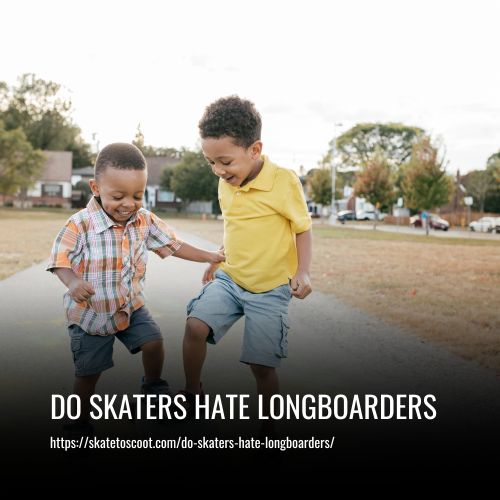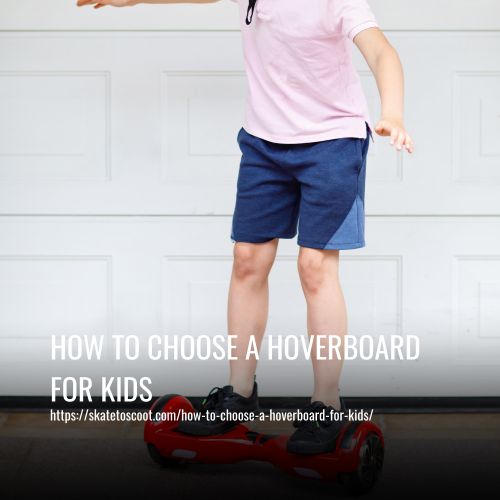As an Amazon Associate we earn from qualifying purchases.
Not all skateboarders hate longboarders, but some do for various reasons. Some skateboarders may dislike longboarders because they can’t perform tricks like ollies, they are seen as posers, or they only ride on flat land. Additionally, some skaters may dislike longboarders because they are associated with mainstream culture.

Skateboarders vs Longboarders
The animosity between skateboarders and longboarders stems from the different characteristics and preferences of the two sports. Skateboarders typically focus on quick turns, tricks, and skatepark sessions, while longboarders prioritize versatility and enjoy cruising on pavements.
Skateboarding is dominated by professional athletes, resulting in a highly competitive and skill-driven community. On the other hand, longboarding appeals to a wider range of enthusiasts, including beginners and veterans, due to its slower pace and ease of control.
The differences in preferred terrains also contribute to the tension. Skateboarders thrive on adrenaline rushes from competitions and street skating sessions with friends, while longboarders prefer open roads and pavements for a more relaxed and enjoyable ride.
Origins of the Hated Relationship
The animosity between skateboarders and longboarders can be traced back to the early origins of both sports. Skateboarding gained popularity in the late 1800s while longboarding emerged in the 1970s as an alternative way to ride on streets and sidewalks.
One of the reasons for the tension between skateboarders and longboarders is the perceived difference in speed. Longboarding is often seen as slower than skateboarding because it relies more on balance and momentum rather than pure speed. Longboards are typically longer than skateboards, which can make them more difficult to control at high speeds on hills or city streets.
Skateboarders are obsessed with image
Skateboarders are deeply passionate about their sport and take their image very seriously. From the way they dress to their attitude when skating and doing tricks, skateboarders strive to embody the essence of skateboarding culture. This dedication to maintaining a certain image is a big part of why skateboarders may have negative attitudes toward longboarders.
Skaters see themselves as part of an exclusive community and have a strong desire to differentiate themselves from those they consider to be “posers” or “kooks.” They view these individuals as outsiders who only use skateboarding as a means to fit in or appear cool. Skateboarders believe that true skaters are those who live and breathe the sport, constantly pushing themselves to learn new tricks and improve their skills. As a result, they often look down on those who simply own a skateboard but don’t put in the effort to truly embrace the skateboarding lifestyle.
Insecurity and the need to be perceived as “cool” and unique also play a role in skateboarders’ negative attitudes toward longboarders. The skateboarding community values authenticity and originality, and some skateboarders may perceive longboarders as diluting or watering down the sport’s rebellious and edgy image. This can lead to a sense of superiority among skateboarders, creating a divide between the two groups.
What is considered a real skater?
A “real skater” in the eyes of skateboarders is someone who actively participates in the skateboard culture by skating on the streets, in parks, and in bowls. This definition goes beyond simply owning a skateboard; it involves actively engaging in the sport and dedicating time to practicing tricks and honing their skills. Skateboarders also consider dressing like a skater an important aspect of being a “real skater”.
On the other hand, longboarding is not considered part of the traditional skateboarding culture according to skateboarders. Some even use the term “wrong boarders” to refer to longboarders, indicating their disapproval. Skateboarders may dislike longboarders who own a longboard but rarely use it for skating or only use it for transportation.
They may see these individuals as posers who misrepresent themselves as skaters. The skateboarding lifestyle is often associated with skating regularly and passionately. However, some skateboarders fail to recognize that older longboarders may have other responsibilities, such as jobs and children, limiting their availability for skateboarding.
The Real Reason Why Skaters Hate Longboarding
The real reason why skaters hate longboarding is due to a feeling of superiority. Skateboarders have been part of the skateboarding culture for much longer than longboarders and are highly protective of their image and lifestyle.
1. Longboarding is easier than skateboarding
Longboarding is often seen as easier than skateboarding by skateboarders. While there are certainly difficult tricks in longboarding, for the most part, they are easier to execute than those in skateboarding. For example, a longboarder who has been practicing for a few years may struggle to perform a kickflip on a regular skateboard.
In contrast, a skateboarder can typically perform basic tricks on a longboard with relative ease. Even the act of simply standing on a longboard is considered easier compared to a regular skateboard. This ease of use is one reason why many people choose longboarding over skateboarding. However, it is important to note that top longboarders can perform advanced tricks that regular skateboarders may find challenging.
2. The longboarding community is small
Reason number 2 why skaters may dislike longboarders is the size of the longboarding community. While skateboarding has a dedicated and passionate community with people who dedicate their lives to the sport, longboarding is often seen more as a hobby or mode of transportation.
Skateboarding enthusiasts are deeply invested in the sport, starting their own companies, organizing events, and advocating for the construction of skateparks. Lifelong dedication is common, with many skateboarders actively involved in the scene.
In contrast, longboarding is often just something people try out during their college years or as a casual form of transportation. Few longboarders take the time to learn tricks or fully commit themselves to the sport. While there are committed longboarders and some form of community, it is not as extensive or serious as the skateboarding community.
3. Longboarding doesn’t look good
Longboarding doesn’t always receive positive feedback from skateboarders when it comes to its appearance. In the world of skateboarding, style is essential, and what is considered visually appealing differs from longboarding. Longboarders often perform tricks involving placing their hands on the ground, stepping off their boards, or executing excessive powerslides, which can be frowned upon in skateboarding.
Even the way someone looks while riding a longboard may not be appealing to most skateboarders. This isn’t to say it should or shouldn’t be this way, but it is the current reality. The design of longboards makes it challenging to perform tricks that would be visually pleasing to skateboarders. Compared to regular skateboards, longboards are bulkier and less maneuverable, resulting in longboarding tricks often appearing awkward and clunky.
4. Longboarders get in the way at skateparks
Longboarders often get in the way at skateparks, which can lead to frustration among skateboarders. While longboarders are not as common at skateparks, their lack of experience and understanding of basic skatepark etiquette can be a problem. Many longboarders are unfamiliar with the unspoken rules of the skatepark, such as not snaking others, going with the flow of the park, and avoiding standing or sitting on ramps. This disregard for basic skatepark etiquette can rub skateboarders the wrong way.
It is important to note that this issue is not exclusive to longboarders, as new skateboarders also struggle with understanding the rules. However, since there is already a general dislike towards longboarders among skateboarders, their lack of adherence to skatepark etiquette only further contributes to the negative perception.
5. Longboarders are seen as posers
Longboarders are often seen as posers by many skateboarders. While some longboarders may take the time to learn how to ride around and do a few tricks, it is generally considered less difficult and time-consuming than skateboarding. Skateboarding requires taking risks, investing significant time and effort to improve skills, and earning one’s stripes.
In contrast, longboarders are sometimes perceived as pseudo-skateboarders who haven’t put in the same level of dedication. They may dress like skateboarders and try to give off the skateboarder vibe, but they are not seen as having earned their place in the skateboarding community.
6. Longboarding is more corporate
One reason skaters may dislike longboarders is the perception that longboarding is a more corporate activity. Skateboarding has always been rooted in underground culture, and skaters pride themselves on supporting smaller, skater-owned companies. This helps protect the skateboarding scene from becoming too commercialized and ensures that skaters are invested in the culture rather than just making money.
In contrast, the majority of longboard companies are larger corporations primarily concerned with profit. This lack of connection between longboarders and the brands they support further exacerbates the issue. Skaters prioritize supporting smaller skate companies, while longboarders often disregard the importance of community and brand connection.
Though not perfect, skateboarders generally try to support smaller brands, while longboarders are often seen as indifferent. This perception of longboarding as a more corporate activity stands in stark contrast to the core values of the skateboarding community, causing some skaters to harbor negative feelings towards longboarders.
7. Longboarding has fewer tricks
One of the main reasons why skaters may have some dislike towards longboarders is the limited variety of tricks available in longboarding. Unlike skateboards, longboards lack a nose and tail, making it impossible to perform certain flips and tricks commonly seen in skateboarding. Longboards are also not designed for skatepark elements like ramps, rails, or gaps. As a result, the range of tricks that can be done on a longboard is significantly narrower compared to skateboarding.
Skateboarding is celebrated for its endless variety of tricks, with no limit to what can be accomplished. Longboarding, on the other hand, offers a more limited repertoire of tricks, primarily focused on powerslide variations. While some longboarders do put effort into mastering advanced tricks, skaters may view it as a waste of talent since the potential for skill progression is relatively limited.
This is akin to other hobbies like scooter riding or rollerblading, where even if impressive tricks are achieved, the overall skill ceiling remains lower compared to skateboarding. Although skaters may appreciate the tricks that longboarders perform, they may question the allocation of time and effort towards something with fewer possibilities.
8. Skaters hate everything
Skaters hate longboarders, but that’s just a small part of it – skaters kind of hate anything that isn’t skateboarding. Skateboarding has its roots in counterculture, so it’s natural for skaters to have a disdain for anything mainstream or different. Whether it’s other sports, certain types of clothes, or even longboarding, skaters always find something to hate on.
But here’s the thing – if you enjoy longboarding, don’t let the hate get to you. Skaters may think longboarding is lame, but if it brings you joy, then go for it. The purpose of this post isn’t to compare skateboarding vs longboarding and determine which one is better. It’s simply to shed light on why some skaters don’t like longboarding.
9. Skaters Are Tribal
Skaters, like any other subculture, can be tribal and resistant to change. Some skaters have a strict view of what constitutes “real” skateboarding and see anything outside of that as a threat. This mentality can lead to animosity towards longboarders.
In this tribal mindset, skaters may criticize those who wear skate shoes or clothing from skate brands if they don’t fit their definition of a “true” skater. They may even question someone’s moral compass based on their choice of shoes, such as Nike SB.
Being a part of a specific skate culture means adhering to certain rules and norms. Anything that deviates from these norms, like longboarding, can be seen as an enemy. This behavior tends to be more prevalent in larger cities where the skate scene is more established.
10. Longboarding Looks Dorky
Many skaters hold the belief that longboarding looks dorky or uncool compared to traditional skateboarding. While this perception is entirely subjective and not a valid reason to hate longboarders, it is a sentiment that some skaters share. The larger size of longboards and the way they are carried can be seen as awkward and unappealing. For those who aren’t actively involved in skateboarding, the concept of longboarding may not make sense or hold any appeal.
Additionally, the presence of older individuals riding electric longboards, often with hipster beards and dorky helmets, is perceived as cringeworthy and out of touch with the skateboarding culture. Skaters may also feel that e-boarders, in general, lack the necessary skills and knowledge to truly embrace the skateboarding community.
While it is essential to recognize that this perspective is not universally held among skaters, it highlights an aspect of the divide between skaters and longboarders in terms of aesthetic preferences and cultural identity.
11. Longboarders Don’t Follow Skate Park Etiquette
Longboarders not following skate park etiquette is indeed a common issue. While some longboarders may adhere to the unwritten rules, there are instances when they unintentionally disrupt the flow of the skate park. This can include snaking others, not understanding the lines, staying in the bowls for extended periods, or hanging out on obstacles. As a result, longboarders often face more criticism compared to regular skateboarders.
However, it is important to note that not all longboarders exhibit these behaviors. There are skilled longboarders who respect the skate park etiquette and contribute positively to the community. In fact, I recently witnessed a longboarder in my local park who impressed everyone by ripping the bowl. He earned the respect and admiration he deserved.
12. Longboarding Isn’t as Popular
Longboarding is not as popular as traditional skateboarding. The longboarding community is relatively small, and you rarely see longboarders riding in groups. Unlike skateboarders who often dedicate their lives to skateboarding, longboarders tend to see it as a fun workout and ride for shorter periods of time before losing interest.
This difference in popularity and dedication may lead some skateboarders to dislike longboarders. Some skateboarders view longboarders as quitters who don’t take risks and don’t fully embrace the skateboarding lifestyle, which is seen as a way to express oneself.
13. Longboarding Tricks Are Limited
Longboarding tricks are limited compared to skateboarding due to the design and purpose of longboards. While skateboarding has an extensive repertoire of tricks, some of which are so unique they don’t even have names, longboards have a more restricted range of possibilities.
Longboards often lack a nose and tail, making it challenging to perform tricks that involve popping the board. The absence of concave cocktails further limits the trick potential. Longboards are primarily designed for long-distance riding and transportation rather than performing tricks.
14. Skateboarders Are Toxic
Skateboarders are often seen as toxic due to the behavior of a specific subset within the skateboarding community. This toxic behavior can include arrogance, ego, and a sense of elitism. Some skateboarders may display a negative attitude towards longboarders and individuals who do not adhere to their specific skateboarding preferences.
This toxic behavior can be detrimental to both the image of skateboarders as well as the overall skateboarding community. It creates an atmosphere of hostility and discourages others from participating in skateboarding.
However, it is important to note that not all skateboarders exhibit toxic behavior. There are many skateboarders who are humble, likable individuals and actively contribute to their communities. It is crucial to avoid generalizing and painting all skateboarders with the same broad brush.
What Do Skateboarders And Longboarders Have In Common?
Skateboarders and longboarders have a lot in common when it comes to their love for these sports. Both activities offer tons of fun and can help users make friends, even though they are individual sports. Additionally, skateboarding and longboarding can boost confidence as they require a lot of skill and practice to master.
In terms of equipment, both skateboards and longboards have similar components such as trucks, wheels, decks, and bearings. In fact, you can even put longboard wheels on a skateboard and start cruising, although it is important to add riser pads for a proper fit.
While longboarding is generally considered easier than skateboarding due to the wider and longer boards, both sports have their challenges. Skateboards are more prone to getting stuck in cracks and having their wheels blocked by small rocks. On the other hand, longboards have an advantage in that they can navigate large cracks and even commute over tram rails.
FAQs
Skateboarders use regular skateboards, which are smaller and narrower than longboards. Longboarders, on the other hand, ride longer and wider boards specifically designed for cruising and transportation.
The animosity between skateboarders and longboarders can stem from a few reasons. Some skateboarders may see longboarders as less skilled because longboarding tends to focus more on cruising and less on tricks. Additionally, there can be a division in skatepark etiquette and the way each group uses the parking space.
Yes, some misconceptions may include the idea that all skateboarders or longboarders have the same skills or preferences. In reality, both sports have a wide range of skill levels and disciplines within them.
Yes, skateboarders and longboarders can coexist in skate parks. It’s important for both groups to respect each other’s space and follow skatepark etiquette. Communication and understanding between the two can help create a harmonious environment.
Yes, skateboarders can use longboard wheels on their skateboards and vice versa, with the addition of riser pads to ensure a proper fit. This allows for different riding experiences and versatility in different terrains.
Neither skateboarding nor longboarding is inherently better than the other. They simply offer different riding experiences and cater to different preferences. Ultimately, it comes down to personal preference and the style of riding one enjoys.
Conclusion:
The rivalry between skaters and longboarders may be fueled by misconceptions and stereotypes, but at the end of the day, both groups share a love for the thrill of riding on wheels.
Let’s focus on celebrating our shared passion and embracing the diversity within the skateboarding community. After all, whether you’re on a skateboard or a longboard, we’re all just out here enjoying the ride.
Amazon and the Amazon logo are trademarks of Amazon.com, Inc, or its affiliates.



